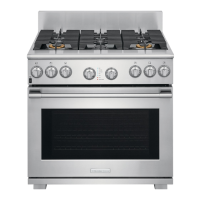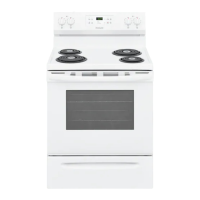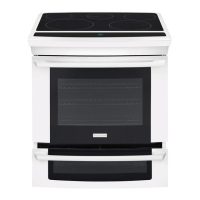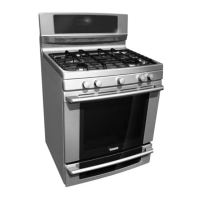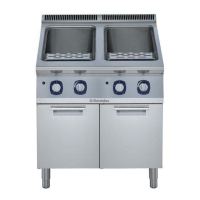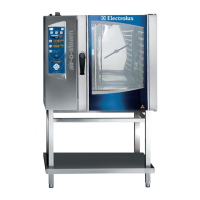
Do you have a question about the Electrolux Range and is the answer not in the manual?
| Brand | Electrolux |
|---|---|
| Model | Range |
| Category | Cookers |
| Language | English |
Details the model designations for built-in ranges and baking ovens within the COMPETENCE series.
Provides the physical dimensions (height, width, depth) of the appliance.
Lists the power outputs and secondary consumers for various heating elements and functions.
Details the parboiling times for the automatic parboiling system based on switch positions.
Describes the control panel layout for the version with maximal equipment, identifying key controls.
Details the interface board for comfort class appliances, used for oven functions and temperature display.
Details the interface board for top class appliances, handling oven functions, temperature, and clock.
Illustrates and describes the power board for the comfort class baking oven.
Illustrates and describes the power board for the top class baking oven, including fuse details.
Illustrates and describes the power board for the hot plates, including fuse details.
Details the components that accommodate LEDs to display cooking levels on the 4 hot plates.
Explains the set value transmitter for hot plates, its function in changing voltage/resistance for temperature control.
Describes the PT 500 temperature sensor used for measuring oven temperature and controlling functions.
Explains the micro switch in pyrolytic appliances that prevents self-cleaning with grates suspended.
Details the specific door lock system for pyrolytic self-cleaning appliances preventing opening during the process.
Guides on setting and modifying the current time on the appliance's control panel.
Detailed steps for setting and modifying the current time on the appliance.
Explains the different clock functions available, such as Period function.
Provides instructions on setting and using the short time function on the appliance.
Instructions on how to switch on a specific baking oven function.
Details on how to adjust the baking oven temperature using the + or – keys.
Instructions for changing the selected baking oven function.
Steps to follow to switch off the baking oven.
Procedure for turning the baking oven's lighting system ON and OFF.
Instructions on how to switch the time display OFF and ON.
Explains how to activate and deactivate the childproof lock for the oven and hot plates.
Provides instructions for activating and deactivating the key lock to prevent unintentional setting changes.
Refers to chapter 6.2.1 for the meaning of the 'tEL' display during pyrolytic cleaning.
Explains the fan running-on function for cooling down the appliance after operation.
Details the pyrolysis function, heating curves, door lock behavior, and cooling fan operation.
Step-by-step guide for executing pyrolytic cleaning, including pre-cleaning steps.
Discusses preventing wrong electrical connections and error codes related to them.
Describes the thermal link (Klixon) that switches off the device in case of overheating.
Details the automatic safety switch-off times for hot plates based on heating stages.
Lists the automatic safety switch-off times for the baking oven based on temperature ranges.
Lists fault codes for Oven and Hot Plates powerboards with corresponding actions.
Provides instructions on how to measure the resistance of the temperature sensor using an ohmmeter.
Explains how to activate and deactivate the test and demo modes for the door lock.
Detailed procedure for activating and deactivating the door lock test for Top/Comfort class appliances.
Instructions for activating and deactivating the demo mode on the appliance.
Diagram of the power board for comfort-input, showing component connections.
Diagram of the power board for top-input, illustrating component connections.
Diagram of the power board for top-output, detailing connections for various appliance parts.
Diagram of the hot plate power board output, showing heating element connections.
Diagram of the hot plate power board input, detailing connections for knobs and displays.
Step-by-step guide for unhinging and dismantling the baking oven door.
Instructions for removing the two-part housing cover of the appliance.
Guides on how to demount the electronic system, controls, and displays.
Step-by-step instructions for demounting the electronic module from the appliance.
Instructions for demounting the 7-segment display for the hot plates.
Procedure for demounting the set value transmitter of the hot plates.
Instructions on how to loosen mounting bolts and withdraw the temperature sensor.
Steps for loosening lateral mounting bolts and removing the door lock.
Instructions for loosening mounting bolts, removing the covering plate, and the fan impeller.
Procedure for loosening rear cover bolts and removing the cross flow fan.
Provides tips for common baking issues and their solutions.
